Essential Slippers Features for Seniors' Comfort
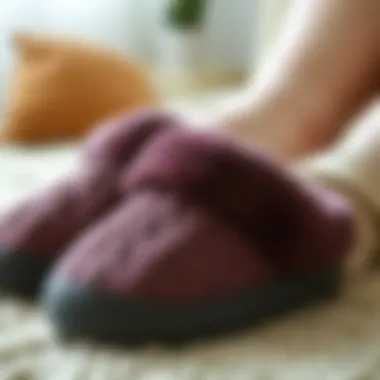
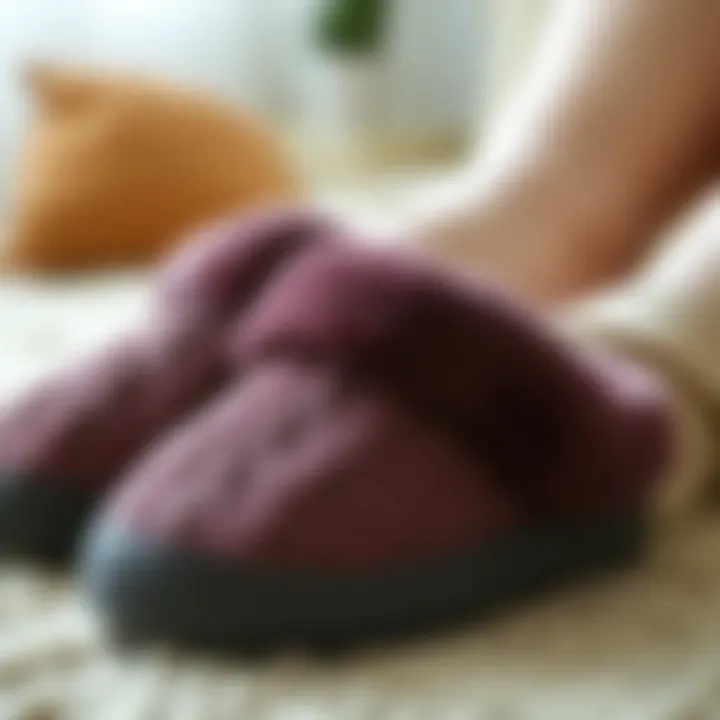
Intro
As we navigate through the stages of life, certain necessities become paramount, particularly concerning our daily comfort and safety. One such essential is footwear, and when it comes to older adults, the stakes get even higher. Slippers, while often viewed as mere home footwear, embody a critical intersection of comfort, support, and style. They are not just footwear, but also a protective layer that significantly impacts the quality of everyday life.
In this article, we’ll delve into the various elements that caregivers and the older population should consider when choosing slippers. Features such as traction, insulation, and ease of wear will be evaluated, alongside an emphasis on innovative designs that meet the unique demands of aging feet.
So, let’s explore what makes the right pair of slippers a necessity rather than a luxury for our senior community.
Comfort and Support
Comfort is the name of the game when it comes to footwear for older adults. Slippers should cradle the foot, providing ample cushioning without compromising structural support.
- Material Matters: Look for slippers made from breathable fabrics like cotton or wool that allow for ventilation. Memory foam insoles can provide personalized comfort, hugging the foot in all the right places.
- Fit is Key: Slippers that are too loose can lead to missteps, while those that are too tight may cause discomfort. Proper sizing is crucial to prevent falls, so ensure that the slipper provides a secure fit yet allows freedom of movement.
Furthermore, some slippers come with arch support—a feature not commonly considered, yet critical for those who spend long periods standing or walking inside their homes.
Safety Features
When it comes to older adults, safety should never take a backseat. Slippers should be equipped with features that minimize risks and maximize confidence in mobility.
- Non-Slip Soles: The bottom of the slippers is where traction becomes essential. Opt for slippers that have rubber soles to ward off slippery surfaces.
- Easy On and Off: Velcro straps or stretchy elastic materials make a world of difference, especially for those with limited dexterity. These designs promote independence, allowing the wearer to put them on and take them off without assistance.
Fashion Considerations
The perception that slippers can't be stylish is a prevalent myth. Nowadays, there is a significant variety of designs that marry functionality with fashion.
- Trendy Designs: Slippers today can come in myriad designs—from chic mules to cozy booties. Embracing a sense of style doesn’t have to be lost in the quest for comfort. In fact, seniors can express their individuality just as well as anyone else.
- Color and Patterns: Offering choices beyond bland colors can uplift the wearer’s spirit. Whether it's bold prints or classic neutrals, the right slipper can boost one’s mood as well as their safety.
"A great pair of slippers can serve not just as protection for your feet, but as a small piece of joy in your everyday routine."
Durability and Quality
Buying quality slippers is, at times, a matter of investing in comfort that lasts. Rather than opting for the cheapest option available, look for durable materials that withstand the test of time.
- Craftsmanship: Handmade slippers often offer superior attention to detail, providing both beauty and longevity. Brands with a good reputation in the slipper market often highlight their quality craftsmanship in their product descriptions.
Finale
Choosing the right slippers for older adults encompasses more than just picking a pair of shoes. It’s about ensuring that every step they take is enveloped in comfort, safety, and style. Every detail—from the material, safety features, to the overall design—plays a part in enhancing the well-being of our cherished seniors.
In this guide, we’ve explored key factors to consider when selecting slippers, proving that thoughtful choices can indeed make a significant difference in the daily lives of older adults. As caregivers or as older individuals themselves, the next step can directly influence mobility and quality of life, marking a change from mere necessity to admirable consideration.
For more information on selecting suitable slippers, consult resources like WebMD and the American Orthopaedic Foot & Ankle Society for detailed insights on foot care.
Prologue to Footwear for Older Adults
Selecting the right footwear for older adults isn’t just a simple matter of aesthetic appeal. It plays a significant role in daily life, impacting everything from mobility to overall health. As individuals age, their physical capabilities can diminish. This means choosing slippers that cater to their specific needs becomes a crucial aspect of maintaining a comfortable and active lifestyle. Appropriate footwear serves as a supportive base, helping to prevent slips, falls, and injuries. Older adults often deal with conditions like arthritis, diabetes, or vascular issues, making comfort a non-negotiable element when it comes to footwear.
When you think about slippers, the first thing that generally comes to mind may be warmth and coziness. However, the needs of older adults extend far beyond that. Supportive footwear can help mitigate the risks of accidents, facilitate mobility, and even alleviate some physical discomforts. This narrative will delve into various aspects that make slippers particularly suitable for seniors, taking into account factors like material, fit, and design.
Additionally, slippers for older adults should be evaluated not only for their functionality but also for the style they offer. Often times, older adults might feel that practical choices come at the expense of fashion. This assumption can discourage them from wearing what they need to stay safe. We will explore how innovative designs can marry both comfort and elegance, ensuring that seniors feel good in their slippers without compromising safety. By understanding the full landscape of footwear needs among older adults, caregivers and family can make informed decisions that enhance their loved ones’ quality of life.
Understanding the Needs of Older Individuals
Older adults have unique needs when it comes to their footwear. It's not just a product they wear on their feet, but rather a tool that supports their daily activities. One should consider various factors such as changes in foot structure over time, potential health issues, and the necessity for ease of wear. For instance, feet can swell due to various conditions such as poor circulation or diabetes, and the structure itself can become less forgiving due to age-related decline.
Moreover, some older adults may experience cognitive or mobility challenges which complicate their choice of suitable footwear. For such individuals, the slipper design ought to reflect functionality—wide openings, hook-and-loop closures, or elasticized materials can play a key role here. Aging isn’t one-size-fits-all; customizing footwear to meet individual needs fosters independence and confidence.
Importance of Appropriate Footwear
Choosing the right slippers goes far beyond merely keeping feet warm; it can have significant implications for both safety and health. Considering that many accidents among older adults occur at home, especially in potentially slippery environments, a wise footwear choice can act as a first line of defense against serious injuries. Slippers that land beneath the foot must feature non-slip soles to reduce the risk of falls.
Additionally, wearing improper or ill-fitted slippers can lead to long-term issues. For example, prolonged use of unsupportive footwear may cause foot deformities or exacerbate existing conditions such as plantar fasciitis. It's crucial, then, to be mindful of not only style but also the essential factors of cushioning, arch support, and breathability.
Proper footwear is a healthcare priority for the elderly; neglecting this aspect can pave the way for serious complications.
Key Features of Slippers for Seniors
When it comes to selecting slippers for older adults, certain features stand out prominently. It’s not just about style or price; it’s about meeting the specific needs that arise as one ages. Every characteristic plays a vital role in ensuring not just comfort, but also safety and accessibility. Therefore, understanding the key features will equip caregivers and seniors alike with the knowledge to make an informed choice that aligns with lifestyle demands.
Cushioning and Support
The significance of cushioning and support in slippers for older adults cannot be understated. As the body ages, foot structure often changes, leading to increased sensitivity and discomfort. Quality cushioning acts like a gentle hug for the foot, absorbing shock and reducing strain on joints. Consider memory foam or gel inserts; they adapt to the foot's unique shape, providing personalized support that can help alleviate issues such as plantar fasciitis or arthritis.
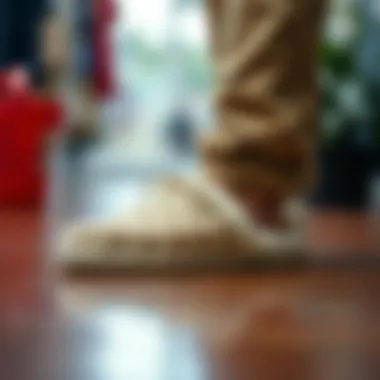
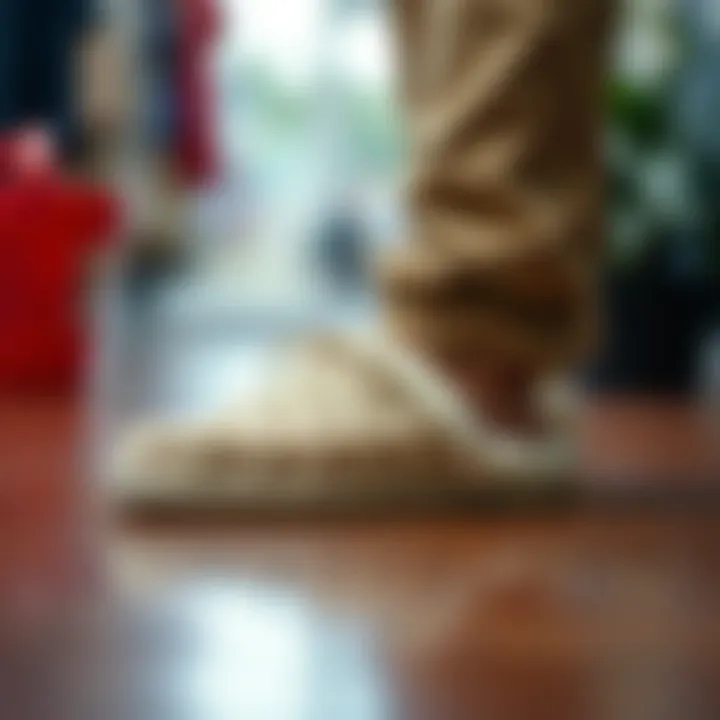
- Impact of Poor Cushioning: Without proper cushioning, there’s a risk of injuries from slips or falls, a common concern for seniors. This can lead to further mobility issues, costing not just physically, but mentally as well.
- Supportive Features: Look for slippers with arch support, as these help distribute weight evenly, mitigating fatigue that can come from prolonged standing or walking.
Easy to Wear Designs
Simplicity is key when choosing slippers for seniors. Easy-to-wear designs facilitate independence, making it simple for older adults to slip them on without hassle. Features like wide openings, stretchy materials, or even backless designs contribute significantly to ease of wear. Here’s why it matters:
- Accessibility: Many seniors face mobility challenges. Shoes that are difficult to put on can discourage them from wearing them altogether. A supportive slipper that can be worn with ease empowers them.
- Adjustability: Styles with adjustable straps or elastic bands can accommodate swelling or foot changes, providing a secure fit without discomfort.
Non-slip Soles
The importance of non-slip soles cannot be overstated when it comes to footwear for the elderly. Slips and falls are a leading cause of injury among older adults, and the right soles can significantly reduce this risk. A few points to consider include:
- Material Matters: Look for outsoles made of rubber or similar materials that provide excellent traction. The tread pattern can also have a tremendous effect on slip prevention.
- Indoor vs. Outdoor Use: It's worth noting that while some slippers are designed for indoor use, others can be suitable for short trips outside. Understanding where the slippers will be worn can help ensure the right design is chosen.
"Selecting the appropriate slippers isn’t just a task; it’s a step towards safeguarding mobility and independence for seniors."
Understanding these key features helps ensure that the slippers chosen are not only functional but enhance the overall quality of life for older individuals. Whether you’re a caregiver or an older adult searching for the right pair, keeping these elements in mind can go a long way in making an informed decision.
Materials Used in Senior Slippers
Selecting the right materials for senior slippers is not merely a matter of preference; it is a key factor that greatly influences comfort, safety, and usability. Older adults often face unique challenges when it comes to footwear, making the choice of materials significant. A slipper that is improperly constructed or made from inferior materials can result in discomfort or even injuries. Therefore, understanding the various materials available is crucial in selecting the best option for seniors.
Breathable Fabrics
Breathable fabrics play a fundamental role in sceneing suitable slippers for older individuals. These materials allow air to circulate, preventing moisture build-up and ensuring that feet remain dry and cool. Fabrics like cotton, bamboo, and specialized mesh provide both comfort and ventilation, which is especially important as many seniors may suffer from conditions like diabetes or reduced circulation that make their feet susceptible to overheating or sweating.
- Key Benefits of Breathable Fabrics:
- Helps to prevent foot odor.
- Reduces the risk of fungal infections.
- Enhances comfort during prolonged wear.
Utilizing breathable options can create a more enjoyable slipper experience while promoting foot health. This is particularly pivotal in maintaining daily mobility, which allows seniors to stay active and independent.
Durable Soles
The soles of a slipper are another critical aspect of its design. Durable soles not only support mobility but also ensure stability—an essential feature given that older adults face a higher risk of slips and falls. Many slippers are constructed with rubber or EVA (Ethylene Vinyl Acetate) soles, as these materials offer traction and shock absorption.
- Advantages of Durable Soles:
- Excellent grip reduces the risk of falls.
- Provides cushioning for comfort while walking.
- Able to withstand wear and tear over time.
When selecting slippers, durability of the soles should be a priority. The last thing a senior needs is to worry about their slippers falling apart during a simple trip across the living room. Quality soles drastically improve safety, enhancing confidence with each step, a must-have for aging individuals who might feel unsteady.
Eco-friendly Options
Today's market offers an increasing number of eco-friendly slipper options. Materials like organic cotton, natural rubber, and recycled materials are becoming popular among manufacturers. Opting for slippers made of sustainable materials not only benefits the environment but may also provide health benefits for seniors. Many environmentally friendly fabrics are hypoallergenic and devoid of harmful chemicals that can irritate sensitive skin.
- Benefits of Eco-friendly Slippers:
- Less exposure to toxic substances.
- Support for sustainable practices.
- Often made using energy-efficient methods that might lead to better craftsmanship.
The eco-friendly proposition holds strong appeal, especially for those conscious about where their products come from. Choosing slippers that incorporate sustainable materials is a step towards not only personal comfort but also contributing to a broader cause.
"Choosing the right materials can transform slippers from mere footwear into an essential ally in promoting health and comfort for older adults."
Incorporating these considerations will lead to better choices, ensuring that older adults have slippers that are not just nice to look at, but practical and highly functional.
Design Considerations
When selecting slippers for older adults, design considerations take center stage. This goes far beyond mere aesthetics; it encompasses both visual appeal and practical functionality, ensuring that the end-user finds delight in their footwear. Each element of the design must meet specific needs that arise with age, such as extra comfort and safety. Those involved in the process of choosing slippers – be it seniors themselves or caregivers – should pay close attention to how these factors intertwine to promote well-being and independence.
Aesthetic Appeal
While comfort is often king in the realm of older adult slippers, aesthetic appeal shouldn't be overlooked. Seniors want to feel dignified and stylish, not as though they are relegated to styles that resemble something out of a hospital supply catalog. Color schemes, patterns, and overall design should resonate with the wearer's personality.
- Vibrant colors can uplift mood without compromising comfort.
- Classic designs often carry nostalgia; they can evoke fond memories, making daily wear more enjoyable.
- Personalization, through custom embroidery or choice of prints, can create a sense of ownership and pride in the footwear.
The right mix of aesthetics caters to an adult's desire for individuality while balancing the need for comfort and security in their daily lives. It shows that they can enjoy beauty even when they require specific adaptations in their choices.
Functional Features
In adding to the design considerations, functional features of slippers play a pivotal role in their overall effectiveness. Seniors’ slippers must be tailored with practical benefits that address common concerns. Key traits to consider include:
Adjustable Straps
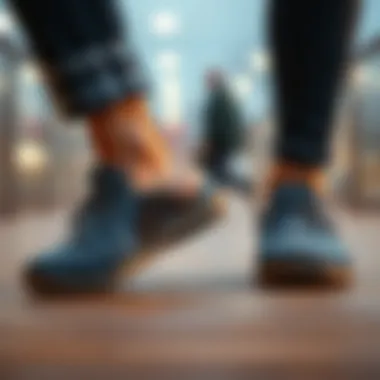
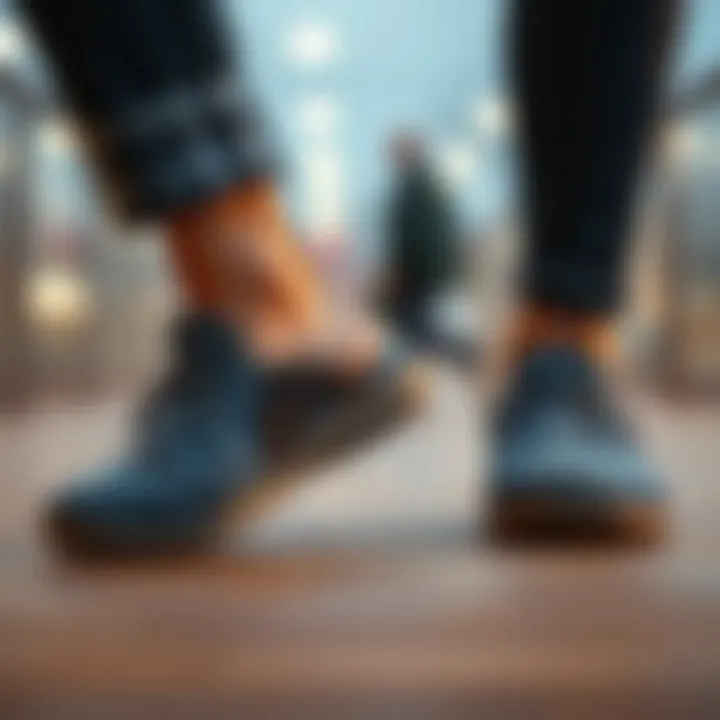
Adjustable straps are a remarkable feature that allows for a custom fit, accommodating the unique shapes and sizes of older adult feet. Their main contribution lies in the enhancement of safety and ease of wear.
- A key characteristic of adjustable straps is their adaptability, providing the ability to tighten or loosen based on the wearer's comfort level.
- This feature is not only popular but essential for those with swelling or varying foot sizes throughout the day.
- A unique advantage of such straps is their inclusion of materials that can grip well without causing discomfort. However, one must be cautious because improperly used straps may lead to insecurity or slippage.
Particularly for seniors who may struggle with dexterity, easy-to-manipulate adjustable straps can make the process of putting on slippers a breeze, promoting independence and confidence.
Arch Support
In the discussion about arch support, it’s vital to underscore how this aspect contributes significantly to overall foot health. Proper arch support can relieve pressure on the feet and even reduce the risk of developing foot pain or other related problems.
- The most notable characteristic is that good arch support promotes alignment and can combat fatigue, which is incredibly important for seniors who need to stay on their feet longer.
- Arch support has garnered acclaim for its ability to distribute weight evenly, thus decreasing strain in high-pressure areas like the heels and balls of the foot.
- A potential downside is that not all slippers provide adequate support, meaning some designs might prioritize style over comfort.
Therefore, slippers boasting effective arch support are increasingly seen as beneficial, significantly improving the quality of life through enhanced comfort and mobility in senior footwear.
Ultimately, a careful blend of aesthetic appeal and functional features ensures that slippers do more than just cover feet -- they enhance independence, comfort, and style for older adults who wear them.
Assessing Fit and Sizing
Importance of Proper Fit
The fit of a slipper can greatly influence the comfort and safety of older adults. As individuals age, the structure of their feet often changes due to various factors such as swelling, loss of fat padding, and changes in bone structure. Proper fit is essential not just for comfort, but also for foot health. Ill-fitting slippers may lead to blisters, calluses, or even more serious conditions like bunions. Furthermore, a slipper that is too loose might not provide adequate support, raising the risk of falls, a concern for many seniors.
Good fitting slippers hugs the foot appropriately, allowing for some movement while also keeping the foot stable. When the fit is correct, it enhances natural walking patterns and minimizes discomfort, which ultimately helps in maintaining an active and independent lifestyle.
Sizing Guidelines
Selecting the right size for slippers involves more than just looking at chart values.
- Measure the Foot: To assess the proper fit, it's essential to measure both foot length and width, ideally at the end of the day when the foot is more likely to be swollen. This will provide the most accurate reading.
- Consider the Shape of the Foot: Feet can be different shapes. Some are wide at the toe and narrow at the heel, while others are the opposite. Observing the shape will aid in selecting slippers that are both suitable and comfortable.
- Try Them On: If possible, trying on slippers while standing can be beneficial. The slipper should allow about a thumbnail's width between the longest toe and the end of the slipper.
- Posture Testing: Walk around briefly in the slippers to gauge not only comfort but also how securely they fit. Slippers should stay on without slipping off or pinching anywhere.
- Know the Brands' Sizing: Different brands may have slight variations in their sizing. It’s important to check individual sizing guides.
By adhering to these guidelines, caregivers and seniors can make more informed decisions when selecting slippers that fit well.
Proper fit can prevent discomfort, reduce the risk of falls, and encourage an active lifestyle.
For further guidance on foot health: CDC - Foot Health.
Ultimately, assessing fit and sizing equips seniors with the foot care they need, ensuring stability and comfort with each step.
Evaluation of Popular Brands
The assessment of popular brands for slippers designed for older adults holds significant importance in this article, as it helps caregivers and seniors make informed purchasing decisions. With numerous options on the market, each offering different features and styles, navigating through this sea of choices can be daunting. Therefore, an evaluation of the most reputable brands provides clarity, allowing individuals to pinpoint slippers that align with their specific needs.
Older adults often require footwear that offers not just comfort but also supports their unique health requirements. Factors such as foot conditions, mobility issues, and even personal preferences affect what constitutes the ideal slipper. Notably, evaluating brands doesn’t merely focus on aesthetics or price but involves a comprehensive analysis of features, quality, and user reviews.
Utilizing data from these evaluations can lead to more satisfying choices that enhance well-being and promote mobility. In addition, being cognizant of brand reputation often correlates with the craftsmanship and safety features embedded in the products, which is vital for preventing falls and providing stability.
As we delve deeper, we'll dissect the elements that define the top-rated brands, alongside comparisons that spotlight essential features associated with senior slippers.
Top-Rated Slipper Brands
When it comes to slippers for seniors, certain brands consistently rise to the top of recommendations due to their dedication to comfort, durability, and safety. A few standout brands worthy of consideration include:
- Acorn: Known for their cozy fleece and innovative designs, Acorn slippers often provide excellent insulation and cushioning.
- Orthofeet: Targeting those with specific foot conditions, Orthofeet prioritizes arch support and comfort, ensuring a fit that aids in pain relief.
- L.L.Bean: Their slippers blend classic style with modern comfort, often incorporating water-resistant materials for versatility.
These brands have garnered a reputation for positive user experiences and reliable products, but it’s not just about brand names. The following comparison will dig into the specific features that make these slippers advantageous for older adults.
Feature Comparisons
When comparing slippers from various brands, it’s essential to look beyond the surface and recognize how each feature caters to the needs of seniors. Here’s a breakdown of critical attributes often highlighted in user reviews:
- Cushioning: Look for brands that incorporate memory foam or gel insoles. This type of cushioning can redistribute weight effectively, reducing pressure on sensitive areas while maintaining comfort.
- Sole Materials: Non-slip soles are non-negotiable. Brands that utilize rubber or other similar materials help ensure stability, crucial for older adults who may suffer from balance issues.
- Fit: Adjustable features can dramatically influence the usability of slippers. For instance, brands that provide adjustable straps can help accommodate varying foot shapes, enhancing both comfort and security.
- Breathability: Fabrics that allow feet to breathe, such as cotton blends, help keep them dry and comfortable throughout the day.
By analyzing these features through the lens of top-rated brands, caregivers and seniors can make choices that not only fit personal flair but also prioritize health and safety. Ultimately, these evaluations guide users toward selections that aim to boost their overall quality of life.
User Experiences and Reviews
In the world of footwear, particularly for older adults, personal experiences can paint a vivid picture that specifications simply cannot capture. User experiences and reviews play a pivotal role in shaping expectations and guiding potential buyers. They provide insight not just into the performance of slippers, but also how they integrate into daily living, addressing real-life scenarios that many experts may overlook.
When assessing slippers for older individuals, it's crucial to delve into firsthand accounts. Reviews from actual users can highlight various aspects, such as comfort level, ease of wear, stability, and overall satisfaction. Seniors often face unique challenges, and understanding how others have navigated these can lead to more informed choices. Feedback includes how certain slippers have performed over time, how easy they are to clean, and even how they fit into different living arrangements, for example, in homes with stairs versus single-level dwellings.
"The right pair of slippers can mean the difference between feeling confident at home and constantly worrying about slipping or tripping."
Feedback from Seniors
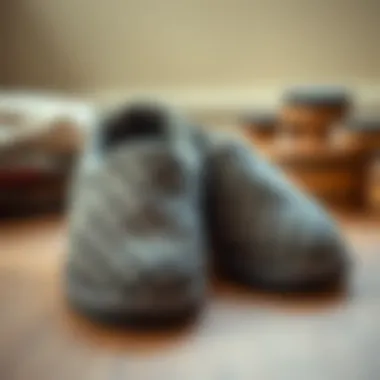
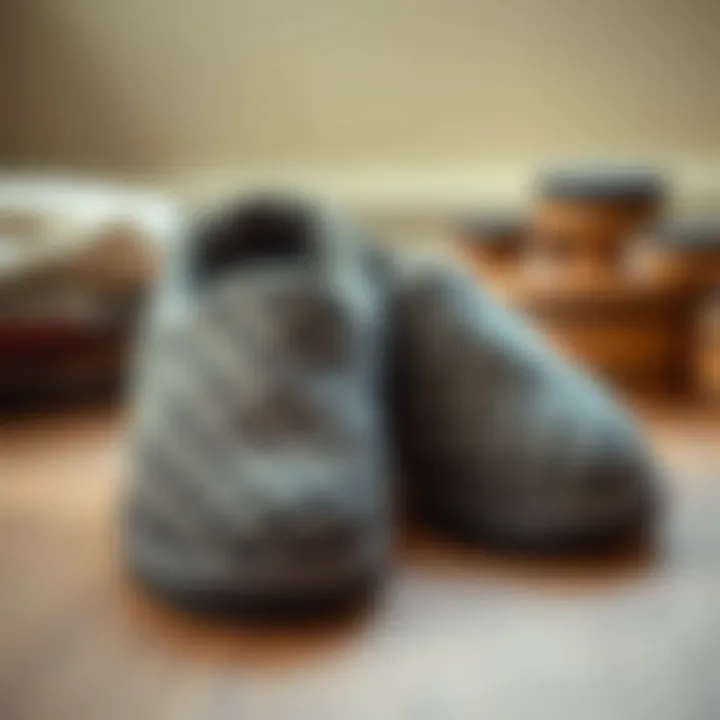
Seniors providing feedback on their footwear reveals a wealth of knowledge regarding both the pros and cons of various styles. Many reviews offer candid insights into how certain slippers have benefitted their daily routines, such as adding a layer of comfort during prolonged wear or enhancing security while moving around the house. Moreover, beyond comfort, peers may also describe the psychological impact of wearing stylish yet functional slippers. Feedback often revolves around the following themes:
- Comfort and Fit: Seniors frequently express how crucial it is for slippers to hug their feet without pinching. Many note that slippers that are too snug can lead to discomfort over time, making it essential to consider user-friendly sizing options.
- Safety Features: Experiences highlight the importance of non-slip soles, especially in homes where falls can lead to serious injuries. Numerous seniors emphasize that this feature not only provides peace of mind but bolsters their confidence in their mobility.
- Durability: Users often share insights regarding the lifespan of slippers, detailing their experiences with wear and tear across various materials and designs. These anecdotes assist others in anticipating which options might withstand everyday use.
Caregiver Insights
Caregivers also bring invaluable perspectives to the table. Their experiences managing the footwear needs of older adults often reveal practical considerations that might not be apparent to first-time buyers. They frequently assess both the functional aspects and emotional connections seniors have with specific styles, as well as their overall well-being. Some common insights from caregivers include:
- Ease of Use: Many caregivers appreciate slippers designed with easy entry features, recognizing that seniors with limited hand strength may struggle with complicated fastenings. Reviews highlight how easy it is for seniors to slip on and off their shoes independently, thereby promoting autonomy.
- Style Versus Practicality: Caregivers often balance their own preferences for aesthetics against the needs of the seniors they assist. They note that while some older individuals favor a more classic look, others may prefer vibrant colors or unique designs that resonate with their personality.
- Long-Term Comfort: Insights emphasize the importance of choosing slippers that maintain comfort over extended wear. Caregivers routinely note that ulcers or other foot issues can arise from inconsistent and poorly designed footwear. This aspect is crucial as it directly relates to the seniors’ overall health and mobility.
As a result, both seniors and caregivers present a holistic view of what to consider when selecting slippers. Their firsthand experiences, while diverse, collectively point toward the practical realities of choosing proper footwear that not only meets the needs of aging bodies but also contributes positively to quality of life.
In summary, the reflections shared by seniors and caregivers alike act as a guiding light for anyone navigating the often muddled waters of footwear for older adults. Their voices echo the significance of safety, comfort, and style—all crucial elements in ensuring that footwear serves a greater purpose in daily living.
Considerations for Specific Conditions
As we venture into the realm of slipper selection for older adults, it's essential to recognize that health conditions can play a significant role in defining an individual's footwear needs. Slippers are not merely a comfort item; they are an integral part of a senior’s daily life and can greatly impact their well-being. In this section, we will explore the importance of considering specific foot conditions and mobility limitations when assessing slippers for our older friends and family members.
Foot Conditions
Older adults might face a variety of foot conditions that can affect their comfort and ability to walk safely. Common issues include arthritis, diabetes, and bunions, each presenting distinctive challenges.
- Arthritis can lead to stiffness and swelling in the joints, making it painful to wear certain types of shoes or slippers. Therefore, choosing slippers with soft materials and cushioning is paramount. Look for options that have a roomy toe box and provide adequate arch support to stabilize the foot without putting pressure on sensitive areas.
- Diabetes brings additional considerations; diabetic patients often experience neuropathy, which can result in a lack of feeling in the feet. It’s crucial to choose slippers that have a seamless interior to avoid rubbing and potential sores. Moreover, ensuring that slippers offer a non-restrictive fit can prevent circulation issues.
- Bunions are another concern. Slippers designed with adjustable features can comfortably accommodate this condition by allowing a personalized fit, thus reducing pain when wearing them.
Mobility Limitations
Mobility limitations can also dictate how effective a pair of slippers will be in providing support and comfort. Many seniors face challenges like reduced balance, difficulty bending down, or the need for assistive devices.
"It's not just about looking good. It's about feeling safe and secure with every step."
Consider slippers that have a low heel or a flat sole, as these styles can enhance stability. Slippers with easy-to-use closures—like Velcro or zippers—allow older adults to wear them without straining or needing help, offering them a sense of independence.
Additionally, look for options with lightweight construction, as cumbersome footwear can lead to fatigue and harm balance. A notable choice are slippers with a sturdy non-slip sole, which can be crucial for preventing slips and falls on smooth surfaces, a common risk in many households.
Keeping all these factors in mind can play a crucial role in promoting a better quality of life for seniors. Each slipper is not just a piece of footwear; it should be a thoughtfully designed tool that caters to specific needs, combining comfort with functionality to maintain both mobility and safety.
Maintenance and Care Instructions
Maintaining slippers requires regular attention, especially for older adults who may rely heavily on them during daily activities. Proper care not just prolongs the lifespan of the slippers but enhances comfort, hygiene, and safety. When healthcare and emotional well-being intertwine, it emphasizes the importance of an appropriately maintained footwear routine.
Cleaning Slippers Properly
Keeping slippers clean is vital for both hygiene and durability. Given that older adults might be more susceptible to foot-related issues, ensuring cleanliness can mitigate risk. Here's how to do it:
- Regular Inspection: It’s wise to routinely check slippers for visible dirt or wear. A quick glance can help identify issues before they worsen.
- Gentle Washing: Most slippers can be washed using mild soap and warm water. It's best to use a soft cloth or sponge to wipe down the outer materials. Avoid harsher chemicals that might degrade the fabric.
- Footbeds Matter: Since footbeds absorb moisture, it’s crucial to clean them more frequently. If they are removable, take them out and wash them separately.
- Drying Technique: Allow slippers to air dry naturally. Avoid heaters or direct sunlight as high temperatures can deform the material.
- Regular Deodorizing: A sprinkle of baking soda can do wonders on the inside. Let it sit overnight and shake out the excess in the morning.
Keeping slippers clean doesn’t just mean aesthetics; it's about creating a safer and healthier environment for seniors.
Extending the Life of Slippers
To make slippers last longer, a combination of smart care and mindful usage is key. Here are strategies for longevity:
- Rotate Usage: Just like you wouldn’t wear the same pair of shoes every day, rotating slippers can prevent excessive wear on one pair.
- Use a Liner: Adding a removable liner can easily absorb moisture and keep the original slipper material fresh. Plus, they can be washed separately to enhance hygiene.
- Proper Storage: When not in use, store slippers in a cool, dry place. Avoid folding them or placing heavy items on top. This simple habit can prevent unwanted creasing and shape distortion.
- Avoid Outdoor Use: If the slippers are intended for indoor use, wearing them outside can quickly wear down the soles. A designated outdoor pair helps reduce the strain on the indoor ones.
- Watch the Sizing: Ensuring the correct fit is crucial. Slippers that are too tight or too loose can lead to faster wear. Regularly check for proper fit and adjust as necessary.
"An ounce of prevention is worth a pound of cure." - Benjamin Franklin
Implementing these maintenance practices can ensure that seniors can enjoy comfortable, safe, and clean slippers for much longer, ultimately enhancing their overall quality of life.
For further resources on maintaining footwear, you can check out CDC Foot Health Resources or explore material on the subject from Mayo Clinic.
The End
As we draw our exploration to a close, it becomes clear that the right slippers for older adults play a pivotal role not only in their comfort but also in their overall health and well-being. Selecting suitable footwear is not merely about aesthetics; it's a decision that directly influences safety, mobility, and quality of life. With the unique physical challenges faced by older individuals, a close examination of the available options is essential.
Recap of Essential Features
When evaluating slippers for seniors, several key features should always be at the forefront:
- Cushioning and support: It’s vital for reducing fatigue and discomfort.
- Easy-to-wear designs: Given mobility challenges, slippers should slip on effortlessly.
- Non-slip soles: These are crucial in preventing slips and falls, which can result in serious injuries.
- Breathable materials: They keep feet dry and comfortable, which enhances daily wearability.
- Durable construction: Slippers should endure daily use without deteriorating quickly.
- Adjustable fit and arch support: These features ensure each slipper accommodates individual foot shapes and offers necessary support.
In addition, emotional aspects like style and personal expression should not be overlooked. As noted, aesthetics matter, as they can influence a person’s confidence and willingness to wear their slippers. Therefore, manufacturers must balance functionality with visual appeal.
Final Thoughts on Footwear Selection
It's not just a purchase; it's an investment in a better quality of life. Caregivers, family members, and the seniors themselves should engage in discussions about footwear options, ensuring that every choice is personalized and well-informed. When the right slippers are selected, they promote independence and confidence, creating an environment where seniors can feel secure while enjoying their daily activities.
A thorough approach to this footwear selection process, backed by knowledge and insights from user experiences and brand evaluations, can transform a mundane aspect of daily life into a joyful and supportive experience. Choosing slippers shouldn’t feel daunting; think of it as part of the larger journey toward a fulfilling and active life.
"Good shoes take you good places."
– Unknown
By taking into account the specific features discussed, and maintaining a conscious effort to ensure quality and fit, caregivers and seniors alike can navigate this footwear landscape more comfortably and confidently.







